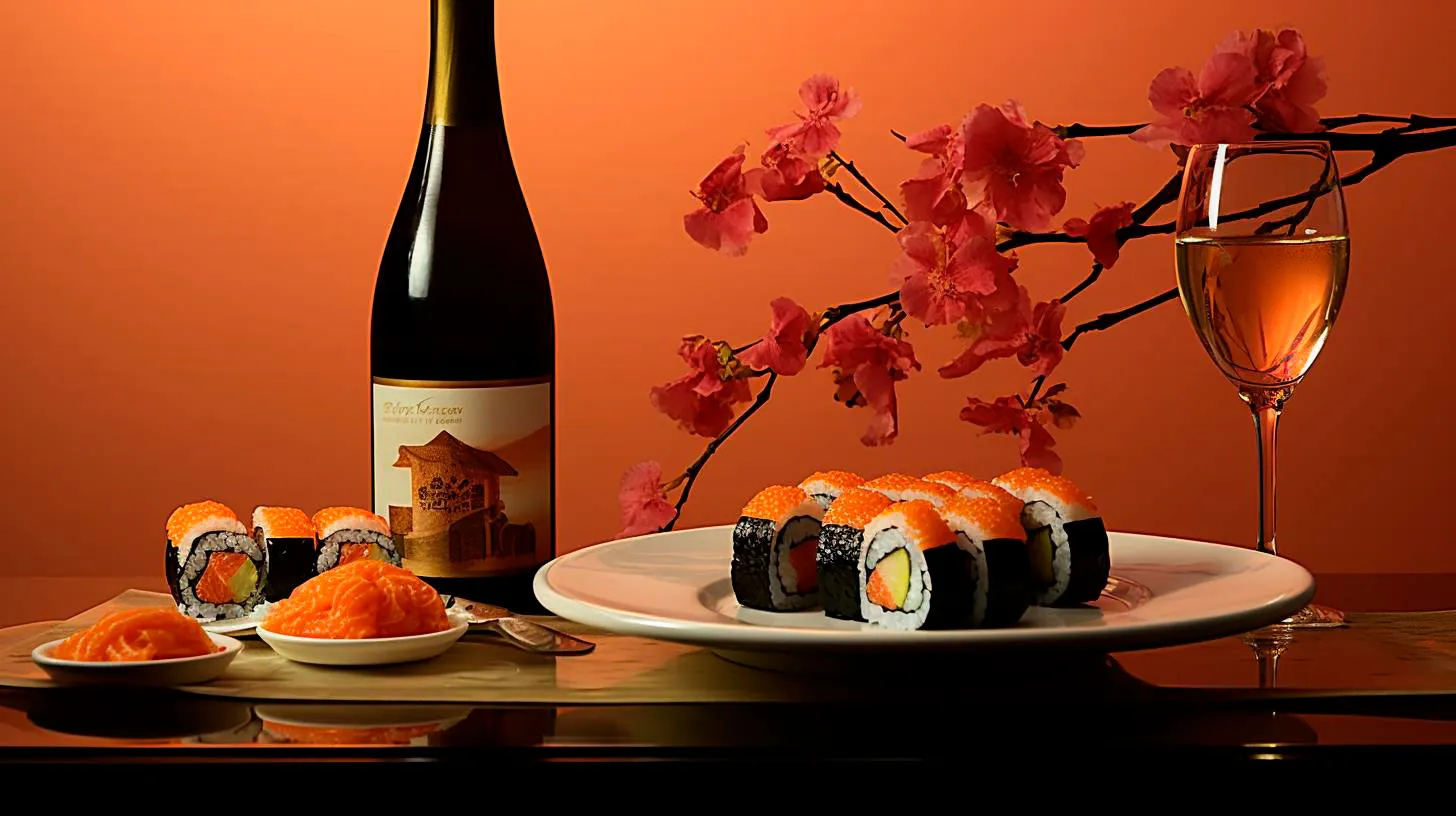The Art of Making Sushi: A Culinary Craft
In this blog article, we will explore the art of making sushi and delve into its rich history, intricate techniques, and the key elements that make it a unique gastronomical experience.
The History of Sushi: A Journey through Time
Sushi has a history spanning over a thousand years. Originating in Southeast Asia, it was initially a way to preserve fish, where it was salted and fermented with rice. This method helped in preserving the fish for long journeys and provided a tangy flavor. Over time, the technique evolved in Japan, and new variations and styles emerged.
Sushi gained international recognition in the 1980s and has since become a global sensation. Its growing popularity can be credited to its distinctive taste, fresh ingredients, and visually appealing presentation.
The Intricate Techniques behind Sushi Making
Making sushi is an art that requires precision, patience, and attention to detail. Several techniques contribute to the crafting of this delightful dish:
- Shari: The vinegared rice, known as shari, is the foundation of sushi. It is cooked and seasoned with a delicate balance of vinegar, sugar, and salt. The rice must be perfectly cooked to achieve the right texture and stickiness.
- Neta: Neta refers to the toppings used in sushi, often seafood. The quality and freshness of the neta are crucial to create a flavorful and delicious sushi. The choice of toppings can range from raw fish to vegetables and even eggs.
- Nigiri: Nigiri sushi is a classic form of sushi in which a small mound of seasoned rice is topped with a slice of neta. It requires skilled hands to shape the rice and delicately place the neta on top.
- Maki: Maki sushi consists of a layer of shari and neta, rolled in seaweed, known as nori. The roll is then cut into bite-sized pieces. This technique allows for creative combinations of ingredients and flavors.
The Delights of Sushi: Key Features and Advantages
Sushi offers a plethora of features and advantages that contribute to its appeal:
- Health Benefits: Sushi is often considered a healthy option as it is low in fat and cholesterol. Its primary ingredients, such as fish rich in omega-3 fatty acids and seaweed packed with vitamins and minerals, make it a nutritious choice.
- Creativity and Variety: Sushi offers endless possibilities for creativity. With a myriad of ingredients, flavors, and presentations, sushi chefs can experiment and create unique combinations to suit different palates.
- Elegance and Presentation: The visually appealing nature of sushi plays a significant role in its popularity. The delicate presentation of vibrant colors and precise arrangements provide a feast for both the eyes and taste buds.
- Sharing and Socializing: Sushi is often shared among friends and loved ones, fostering a sense of community and togetherness. The act of sharing a sushi platter enhances social connections and brings people closer.
Conclusion: Discover the Artistry of Sushi
Sushi is more than just a dish. It is a testament to the mastery of culinary artistry, combining precise techniques, fresh ingredients, and a myriad of flavors. As you embark on your sushi journey, appreciate the historical significance and intricacies involved. Whether you enjoy nigiri, maki, or sashimi, each bite will transport you to a world of taste and craftsmanship.
Indulge in the art of making sushi and delve into a culinary craft that has captivated the world with its elegance, health benefits, and sheer deliciousness.
Key Takeaways:
- Explore the rich history of sushi, originating in Southeast Asia and evolving into a global sensation.
- Learn about the intricate techniques behind sushi making, including the preparation of shari and the delicate art of nigiri and maki.
- Discover the features and advantages of sushi, such as its health benefits, creativity, and elegant presentation.
- Experience the joy of sharing sushi with friends and loved ones, fostering social connections and togetherness.
- Immerse yourself in the artistry of sushi, appreciating the meticulous craftsmanship and unique flavors.
Sushi Health Benefits: Fueling Your Body with Fresh Ingredients
In this article, we will explore the various health benefits of sushi and how it can be a valuable addition to your diet.
1. High-Quality Protein Source
Sushi is predominantly made with raw fish, such as salmon, tuna, or mackerel, which serves as an excellent source of high-quality protein. Protein is essential for building and repairing cells, supporting muscle growth, and promoting overall development. By incorporating sushi into your diet, you can easily meet your daily protein requirements.
Key takeaway: Sushi provides a good amount of high-quality protein, which is necessary for cell repair and muscle growth.
2. Omega-3 Fatty Acids
Many types of fish used in sushi are rich in omega-3 fatty acids – a group of essential fats that our bodies cannot produce on their own. Omega-3s are known for their heart-healthy benefits, including reducing the risk of cardiovascular diseases, lowering blood pressure, and improving overall heart health.
Key takeaway: Incorporating sushi into your diet allows you to consume omega-3 fatty acids, which can support heart health and reduce the risk of various cardiovascular issues.
3. Vitamins and Minerals
Sushi often includes various vegetables like avocado, cucumber, and carrots, which provide an array of important vitamins and minerals. Avocado, for instance, is packed with healthy fats, fiber, and is an excellent source of vitamins C, E, K, and B-6. These vitamins are essential for numerous bodily functions, including skin health, immune system support, and blood cell production.
Key takeaway: Sushi offers a blend of different vegetables containing essential vitamins and minerals, which are beneficial for a well-rounded, nutritious diet.
4. Low in Calories
For those health-conscious individuals aiming to manage their weight, sushi can be a great option. Sushi rolls often contain lean proteins, vegetables, and rice, making them relatively low in calories compared to other fast food options. Additionally, the use of raw ingredients and minimal cooking methods ensures that the nutrients remain intact.
Key takeaway: Opting for sushi can contribute to weight management due to its low-calorie content when compared to other high-calorie fast food alternatives.
5. Low in Saturated Fats
Saturated fats, found in many processed foods, can increase the risk of heart disease and raise cholesterol levels. Choosing sushi over foods high in saturated fats reduces the intake of these unhealthy fats. Moreover, the presence of healthy fats in sushi, such as omega-3s found in fish and avocado, supports heart health and overall well-being.
Key takeaway: Sushi is a healthier alternative to foods high in saturated fats, thereby lowering the risk of heart disease and promoting better heart health.
6. Antioxidant-rich Ingredients
Sushi often incorporates ingredients like seaweed and ginger, both of which are rich in antioxidants. Antioxidants protect our cells from damage caused by harmful molecules called free radicals, reducing the risk of chronic diseases and promoting overall longevity.
Key takeaway: The inclusion of antioxidant-rich ingredients in sushi can provide protection against cell damage and help prevent various chronic diseases.
Conclusion
Incorporating sushi into your diet can offer numerous health benefits. From providing high-quality protein and omega-3 fatty acids to being low in saturated fats and calories, sushi proves to be a nutritious and delicious choice. Moreover, the inclusion of vitamins, minerals, and antioxidants from various ingredients ensures that your body receives a diverse range of essential nutrients.
So, next time you crave a mouthwatering meal, consider sushi as a healthy alternative that not only caters to your taste preferences but also fuels your body with fresh, nutrient-rich ingredients.
Sushi Goes Beyond Raw Fish: Exploring Vegetarian Options
In this article, we will explore the world of vegetarian sushi, its advantages, and key takeaways for sushi enthusiasts.
1. The Rise of Vegetarian Sushi
In recent years, there has been a significant rise in the popularity of vegetarianism and veganism worldwide. As a result, sushi restaurants have expanded their menus to accommodate different dietary preferences. Vegetarian sushi refers to sushi rolls that exclude any animal products and instead focus on plant-based ingredients.
With the increasing demand for vegetarian options, sushi chefs have become creative in crafting innovative and delicious rolls that showcase the natural flavors and textures of vegetables, fruits, and other plant-based ingredients. This has given birth to a whole new world of sushi, where traditional ingredients like fish are replaced with wholesome and nutrient-rich alternatives.
2. The Advantages of Vegetarian Sushi
There are several advantages to exploring vegetarian sushi, even for those who are not strictly following a plant-based diet. Here are some key benefits:
- Health Benefits: Vegetarian sushi incorporates a wide range of fresh and colorful vegetables, which are packed with essential vitamins, minerals, and dietary fiber. It offers a healthier alternative to traditional sushi rolls, which may contain high levels of mercury and other potential pollutants found in seafood.
- Diversity and Innovation: Vegetarian sushi allows for a wider range of flavors, textures, and ingredient combinations. It encourages chefs to experiment with various vegetables, fruits, tofu, and even vegan-friendly faux-fish substitutes to create unique and mouthwatering rolls.
- Environmental Consciousness: By choosing vegetarian sushi, individuals contribute to reducing the carbon footprint associated with the fishing industry. Overfishing and unsustainable fishing practices have had a detrimental impact on marine ecosystems, making vegetarian sushi a more environmentally friendly choice.
3. Exploring Vegetarian Sushi Options
Let’s take a closer look at some popular vegetarian sushi options that you can find at your local sushi restaurant:
A. Vegetarian Roll:
These rolls are made with a combination of fresh cucumbers, avocado, carrots, and daikon sprouts. Their crunchy texture and vibrant colors make them a tempting and refreshing choice.
B. Inari Sushi:
Inari sushi consists of sweet and tangy sushi rice delicately packed inside pockets of seasoned fried tofu. These bite-sized treats are not only delicious but also visually appealing.
C. Tempura Roll:
Tempura rolls feature a delicious combination of deep-fried tempura vegetables, such as sweet potatoes, bell peppers, and zucchini, providing a delightful crispy texture with every bite.
D. Yasai Nigiri:
Nigiri sushi is a traditional form of sushi consisting of a small mound of rice topped with various ingredients. Yasai nigiri showcases an array of vegetarian toppings, including marinated tofu, eggplant, shiitake mushrooms, and pickled radishes.
4. Key Takeaways
The sushi industry has embraced the rise of vegetarianism by offering diverse and exciting options for sushi enthusiasts. Here are the key takeaways:
- Vegetarian sushi is gaining popularity, catering to the preferences of those following plant-based diets.
- Vegetarian sushi offers health benefits, diversity, and innovative flavor combinations.
- Choosing vegetarian sushi promotes environmental consciousness and sustainability.
- Popular vegetarian sushi options include vegetarian rolls, inari sushi, tempura rolls, and yasai nigiri.
So, the next time you visit a sushi restaurant, why not venture beyond the traditional raw fish options and try some of these delicious and nutritious vegetarian sushi rolls? Your taste buds, health, and the environment will thank you!
Sushi Etiquette: How to Enjoy this Traditional Delicacy
In this blog article, we will guide you through the dos and don’ts of sushi etiquette, ensuring you have an enjoyable and authentic dining experience.
The Art of Eating Sushi
1. Use Chopsticks: While it is acceptable to eat sushi with your hands, using chopsticks is the traditional way. Mastering the art of using chopsticks will enhance your overall dining experience and showcase your respect for Japanese customs.
2. Gari – The Palate Cleanser: Japanese pickled ginger called “gari” is typically served alongside sushi. The purpose of gari is to cleanse your palate between different types of sushi, ensuring you fully appreciate the distinct flavors of each piece.
3. Eye Contact and Greetings: When dining at a sushi bar or restaurant, make sure to establish eye contact and greet the sushi chef with a polite “Konichiwa” (Hello) or “Arigato” (Thank you). This gesture shows respect and appreciation for their craftsmanship.
4. Wasabi Placement: Rather than mixing wasabi directly into soy sauce, it is considered proper etiquette to place a small amount of wasabi directly on top of the sushi. This way, you can adjust the level of wasabi to your personal taste.
5. Soy Sauce Usage: When dipping your sushi into soy sauce, avoid over-saturating it. Gently dip the fish side, as dipping rice may cause it to fall apart. The aim is to enhance the flavor of sushi, not overpower it.
Table Manners and Tips for Sushi Dining
1. Eat at a Steady Pace: Sushi is best enjoyed promptly after it is served. Consuming sushi promptly ensures that you savor it at its freshest. Eating slowly also allowed the sushi chef to pace the meal.
2. Familiarize Yourself with Different Types of Sushi: Sushi comes in various forms, such as nigiri (fish on rice), maki (rolled sushi), and sashimi (sliced raw fish). Exploring the different varieties of sushi will enhance your culinary experience and expand your palate.
3. Finger Foods: When presented with hand rolls, it is perfectly acceptable to eat them with your hands. Hand rolls are designed to be consumed promptly, so use your fingers to appreciate the blend of textures and flavors.
4. Dining Environment: It is essential to be mindful of the ambiance within a sushi establishment. Keep noise levels down, avoid using your phone at the table, and be respectful of fellow diners who might be seeking a serene dining experience.
5. Express Appreciation: At the end of your meal, it is customary to express your gratitude to the sushi chef with a genuine “Gochisosama deshita” (Thank you for the meal). This gesture shows respect and appreciation for their craft.
Benefits of Proper Sushi Etiquette
Following proper sushi etiquette not only showcases your respect for Japanese culture but also enhances your overall dining experience. By adhering to these guidelines, you will:
- Immerse yourself in Japanese traditions and experience an authentic sushi meal.
- Ensure that the chef recognizes and appreciates your respect for their craftsmanship.
- Enhance the flavors and textures of each sushi piece, savoring the delicate nuances.
- Create a pleasant and respectful dining environment for you and fellow diners.
- Develop a deeper appreciation for the art and culture surrounding sushi.
In Conclusion
Sushi etiquette is an integral part of the dining experience when enjoying this traditional delicacy. By understanding and adopting the customs outlined in this article, you can fully immerse yourself in the artistry and flavors of sushi while paying homage to Japanese traditions. Slow down, savor each bite, and embrace the beauty of sushi dining—an experience that transcends mere food.


